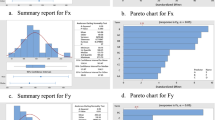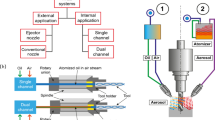Abstract
Due to low thermal conductivity and high chemical reactivity, the aerospace alloy Ti-6Al-4 V has a high cutting temperature and poor machinability in metalworking operations. It results in poor workpiece quality and low tool life, which increases the processing costs. Therefore, an efficient cooling-lubrication technique is requested to solve this problem. Herein, a new system, supercritical CO2 mixed with nanofluid minimum quantity lubrication (SCCO2-NMQL), is used for the cutting process. Supercritical CO2 (SCCO2) produces a low-temperature jet field because of the Joule–Thomson effect after injection and delivers the nanofluids deep into the cutting zone for cooling and lubricating during the cutting process. In this work, the effectiveness of SCCO2-NMQL cooling-lubrication in turning Ti-6Al-4 V was compared with that of other lubrication conditions (i.e., dry cutting, SCCO2, and supercritical CO2 mixed with minimum quantity lubrication (SCCO2-MQL), respectively), in terms of cutting zone temperature, cutting force, surface roughness, and tool wear. In comparison with dry cutting, SCCO2, and SCCO2-MQL, the cutting temperature drops of SCCO2-NMQL are more than 25%, 15%, and 12%, respectively. The use of SCCO2-NMQL cooling conditions provides lower cutting force and a superior surface finish. Moreover, the SCCO2-NMQL cooling condition has the potential to offer a sufficient cooling-lubrication function to tool wear. Results of the work indicate that SCCO2-NMQL can act as an efficient cooling-lubrication technique.










Similar content being viewed by others
Data availability
All data generated or analyzed during this study are included in this published article.
Abbreviations
- SCCO2-NMQL:
-
Supercritical CO2 mixed with nanofluid minimum quantity lubrication
- MQL:
-
Minimum quantity lubrication
- SCCO2 :
-
Supercritical CO2
- SCCO2-MQL:
-
SCCO2 mixed with minimum quantity lubrication
- LN2 :
-
Liquid nitrogen
- SiO2 :
-
Silicon dioxide
- SDS:
-
Sodium dodecyl sulfate
- v c :
-
Cutting speed (m/min)
- a p :
-
Depth of cut (mm)
- f :
-
Feed rate (mm/rev)
- F x :
-
Cutting force along the feed direction (N)
- F y :
-
Cutting force along the radial direction (N)
- F z :
-
Cutting force along the cutting speed (N)
- Ra :
-
Surface roughness of workpiece (μm)
- SEM:
-
Scanning electron microscope
- BUE:
-
Built-up edge
References
Singh R, Dureja JS, Dogra M, Gupta KM, Jamil M, Mia M (2020) Evaluating the sustainability pillars of energy and environment considering carbon emissions under machining of Ti-3Al-2.5V. Sustain Energy Technol Assess 42
Gupta MK, Song Q, Liu Z, Sarikaya M, Jamil M, Mia M, Khanna N, Krolczyk GM (2021) Experimental characterisation of the performance of hybrid cryo-lubrication assisted turning of Ti-6Al-4V alloy. Tribol Int 153
Singh R, Dureja JS, Dogra M, Gupta MK, Mia M, Song Q (2020) Wear behavior of textured tools under graphene-assisted minimum quantity lubrication system in machining Ti-6Al-4V alloy. Tribol Int 145
Mia M, Dhar NR (2017) Influence of single and dual cryogenic jets on machinability characteristics in turning of Ti-6Al-4V. Proc Inst Mech Eng Part B J Eng Manuf 233:711–726
Sartori S, Moro L, Ghiotti A, Bruschi S (2017) On the tool wear mechanisms in dry and cryogenic turning additive manufactured titanium alloys. Tribol Int 105:264–273
Venugopal KA, Paul S, Chattopadhyay AB (2007) Tool wear in cryogenic turning of Ti-6Al-4V alloy. Cryogenics 47:12–18
Danish M, Gupta MK, Rubaiee S, Ahmed A, Sarıkaya M, Krolczyk GM (2022) Environmental, technological and economical aspects of cryogenic assisted hard machining operation of inconel 718: a step towards green manufacturing. J Clean Prod 337
Jamil M, He N, Zhao W, Li L, Gupta MK, Sarikaya M, Khan AM, Singh R (2021) Heat transfer efficiency of cryogenic-LN2 and CO2-snow and their application in the turning of Ti-6AL-4V. Int J Heat Mass Transfer 166
Clarens AF, Hayes KF, Skerlos SJ (2006) Feasibility of metalworking fluids delivered in supercritical carbon dioxide. J Manuf Process 8:47–53
Clifford T (1998) Fundamentals of supercritical fluids. Oxford University Press, Oxford
Supekar SD, Gozen BA, Bediz B, Ozdoganlar OB, Skerlos SJ (2013) Feasibility of supercritical carbon dioxide based metalworking fluids in micromilling. J Manuf Scie Eng 135
Wang S, Clarens AF (2013) Analytical model of metalworking fluid penetration into the flank contact zone in orthogonal cutting. J Manuf Process 15:41–50
Sankaranarayanan R, Hynes NRJ, Kumar JS, Krolczyk GM (2021) A comprehensive review on research developments of vegetable-oil based cutting fluids for sustainable machining challenges. J Manuf Process 67:286–313
Özbek O, Saruhan H (2020) The effect of vibration and cutting zone temperature on surface roughness and tool wear in eco-friendly MQL turning of AISI D2. J Market Res 9:2762–2772
Mia M, Gupta MK, Pruncu CI, Sen B, Khan AM, Jamil M, Faraz S, Asef F, Imran GS, Rahman MA (2020) Six sigma optimization of multiple machining characteristics in hard turning under dry, flood, MQL and solid lubrication. J Prod Syst Manuf Sci 1:57–68
Khanna N, Shah P, López-De-Lacalle LN, Rodríguez A, Pereira O (2021) In pursuit of sustainable cutting fluid strategy for machining Ti-6Al-4V using life cycle analysis. Sustain Mater Technol 29
Ferrouillat S, Bontemps A, Ribeiro J-P, Gruss J-A, Soriano O (2011) Hydraulic and heat transfer study of SiO2/water nanofluids in horizontal tubes with imposed wall temperature boundary conditions. Int J Heat Fluid Flow 32:424–439
Sayuti M, Erh OM, Sarhan AAD, Hamdi M (2014) Investigation on the morphology of the machined surface in end milling of aerospace AL6061-T6 for novel uses of SiO2 nanolubrication system. J Clean Prod 66:655–663
Bai X, Li C, Dong L, Yin Q (2018) Experimental evaluation of the lubrication performances of different nanofluids for minimum quantity lubrication (MQL) in milling Ti-6Al-4V. Int J Adv Manuf Technol 101:2621–2632
Sartori S, Ghiotti A, Bruschi S (2017) Hybrid lubricating/cooling strategies to reduce the tool wear in finishing turning of difficult-to-cut alloys. Wear 376–377:107–114
Pereira O, Rodríguez A, Fernández-Abia AI, Barreiro J, López-De-Lacalle LN (2016) Cryogenic and minimum quantity lubrication for an eco-efficiency turning of AISI 304. J Clean Prod 139:440–449
Pereira O, Català P, Rodríguez A, Ostra T, Vivancos J, Rivero A, López-De-Lacalle LN (2015) The use of hybrid CO2+MQL in machining operations. Procedia Eng 132:492–499
Cai C, Liang X, An Q, Tao Z, Ming W, Chen M (2020) Cooling/lubrication performance of dry and supercritical CO2-based minimum quantity lubrication in peripheral milling Ti-6Al-4V. Int J Precis Eng Manuf-Green Technol
Hao G, Liu Z (2020) The heat partition into cutting tool at tool-chip contact interface during cutting process: a review. Int J Adv Manuf Technol 108:393–411
Yıldırım ÇV, Kıvak T, Sarıkaya M, Erzincanlı F (2017) Determination of MQL parameters contributing to sustainable machining in the milling of nickel-base superalloy waspaloy. Arab J Sci Eng 42:4667–4681
Li HZ, Zeng H, Chen XQ (2006) An experimental study of tool wear and cutting force variation in the end milling of Inconel 718 with coated carbide inserts. J Mater Process Technol 180:296–304
Liang X, Liu Z, Liu W, Li X (2019) Sustainability assessment of dry turning Ti-6Al-4V employing uncoated cemented carbide tools as clean manufacturing process. J Clean Prod 214:279–289
Wang F, Wang Y (2021) Cleaner milling on Ti-6Al-4V alloy cooled by liquid nitrogen: external spray and inner injection. Int J Adv Manuf Technol 112:1193–1206
Jamil M, Khan AM, Gupta MK, Mia M, He N, Li L, Sivalingam V (2020) Influence of CO2-snow and subzero MQL on thermal aspects in the machining of Ti-6Al-4V. Appl Therm Eng 177
Gupta MK, Song Q, Liu Z, Sarikaya M, Mia M, Jamil M, Singla AK, Bansal A, Pimenov DY, Kuntoğlu M (2021) Tribological performance based machinability investigations in cryogenic cooling assisted turning of α-β titanium alloy. Tribol Int 160
Rahmati B, Sarhan AAD, Sayuti M (2014) Morphology of surface generated by end milling AL6061-T6 using molybdenum disulfide (MoS2) nanolubrication in end milling machining. J Clean Prod 66:685–691
Maruda RW, Krolczyk GM, Wojciechowski S, Powalka B, Klos S, Szczotkarz N, Matuszak M, Khanna N (2020) Evaluation of turning with different cooling-lubricating techniques in terms of surface integrity and tribologic properties. Tribol Int 148
Yuan S, Hou X, Wang L, Chen B (2018) Experimental investigation on the compatibility of nanoparticles with vegetable oils for nanofluid minimum quantity lubrication machining. Tribol Lett 66
Ikuta A, Shinozaki K, Masuda H, Yamane Y, Kuroki H, Fukaya Y (2002) Consideration of the adhesion mechanism of Ti alloys using a cemented carbide tool during the cutting process. J Mater Process Technol 127:251–255
Acknowledgements
The authors would like to thank the company Dongguan Armorine Machinery Manufacturing Technology Co., Ltd., China, for the supporting experimental equipment and technology.
Funding
This research is supported by the National Natural Science Foundation of China (Grant No. [51905144]).
Author information
Authors and Affiliations
Contributions
All of the authors contributed to the study’s conception and design. All of the authors commented on versions of the manuscript. All of the authors read and approved the final manuscript.
Corresponding author
Ethics declarations
Ethics approval
Not applicable.
Consent to participate
The authors consent to participate.
Consent for publication
The authors consent to transfer the copyright of the article to publish.
Conflict of interest
The authors declare no competing interests.
Additional information
Publisher's Note
Springer Nature remains neutral with regard to jurisdictional claims in published maps and institutional affiliations.
Rights and permissions
Springer Nature or its licensor holds exclusive rights to this article under a publishing agreement with the author(s) or other rightsholder(s); author self-archiving of the accepted manuscript version of this article is solely governed by the terms of such publishing agreement and applicable law.
About this article
Cite this article
Huang, H., Liu, ·., Zhu, L. et al. Cooling and lubrication performance of supercritical CO2 mixed with nanofluid minimum quantity lubrication in turning Ti-6Al-4 V. Int J Adv Manuf Technol 122, 2927–2938 (2022). https://doi.org/10.1007/s00170-022-10091-9
Received:
Accepted:
Published:
Issue Date:
DOI: https://doi.org/10.1007/s00170-022-10091-9




